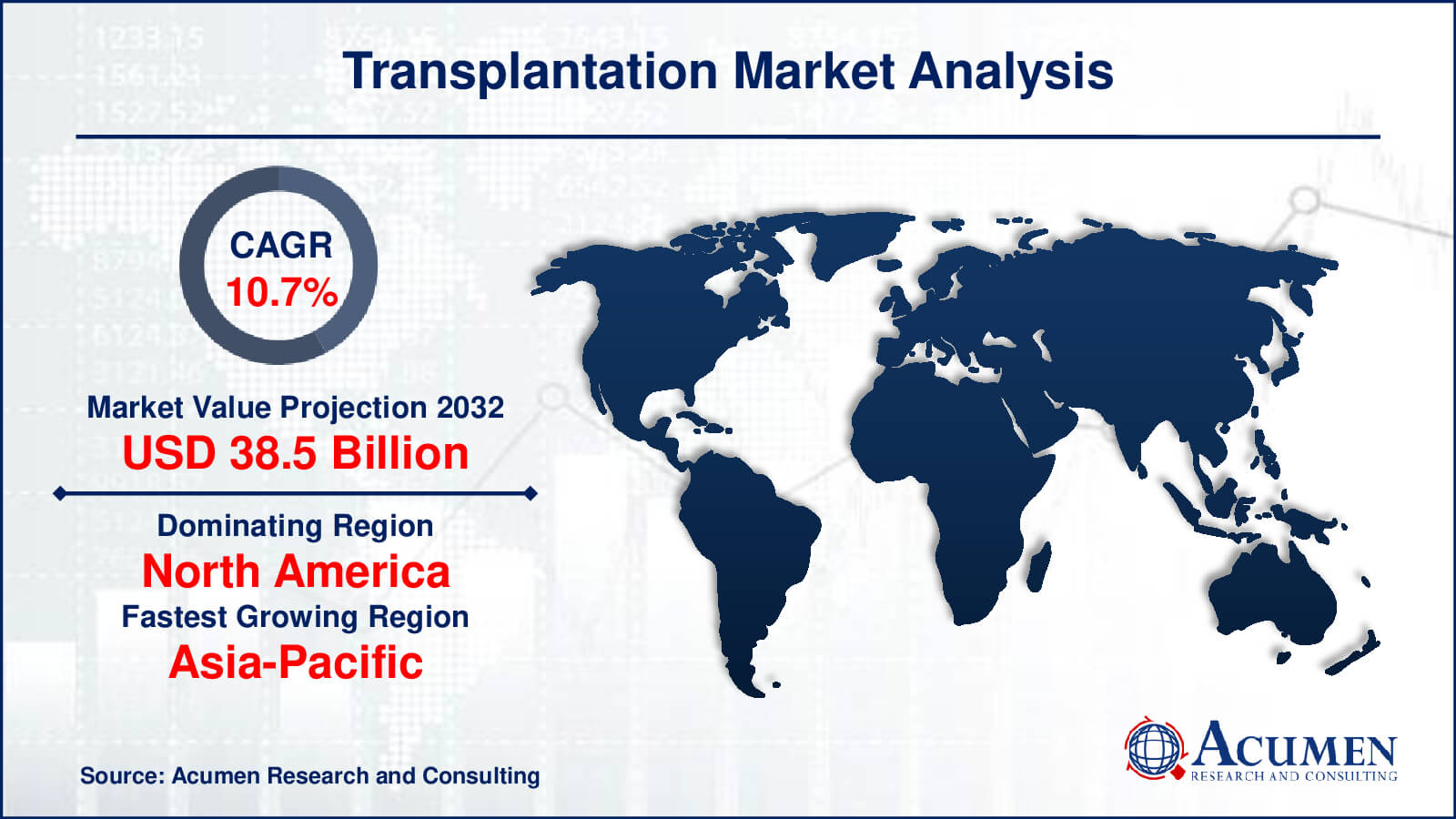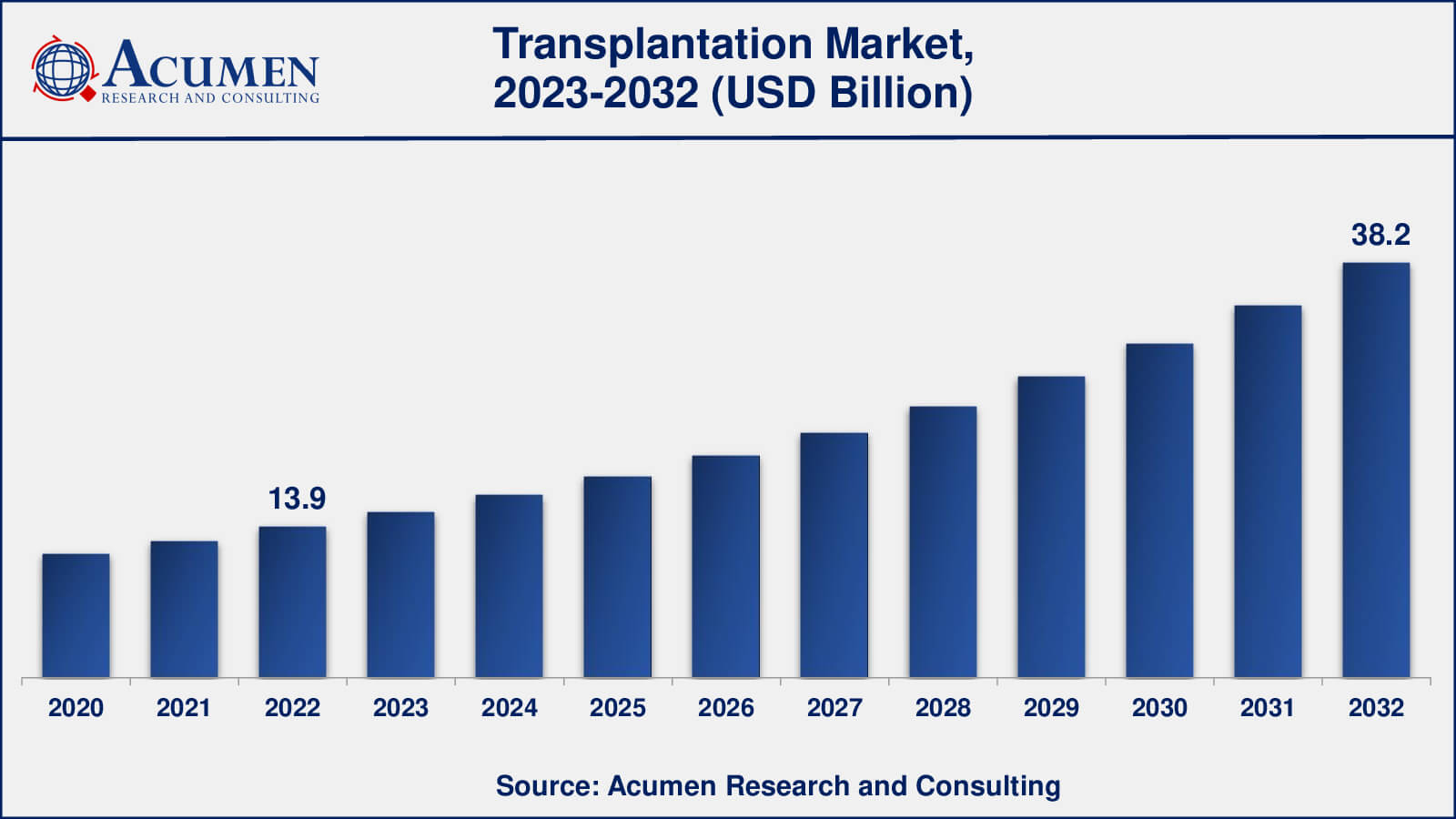January 2024
Transplantation Market size was valued at USD 13.9 Billion in 2022 and is projected to attain USD 38.2 Billion by 2032 mounting at a CAGR of 10.7% from 2023 to 2032.
The global Transplantation Market size was valued at USD 13.9 Billion in 2022 and is projected to attain USD 38.2 Billion by 2032 mounting at a CAGR of 10.7% from 2023 to 2032.
Transplantation Market Highlights

Transplantation is a medical operation in which organs, tissues, or cells are transferred from one person, known as the donor, to another person, known as the recipient, in order to replace damaged or non-functioning bodily components. This sophisticated medical practice has been a critical advance in contemporary medicine, providing patients suffering from a range of ailments and disorders with hope and frequently life-saving remedies. The basic goal of transplantation is to restore normal organ or tissue function in the recipient, therefore improving or perhaps preserving their life.
One of the most difficult aspects of transplantation is assuring compatibility between the donor and the recipient in order to reduce the chance of rejection. Tissue type, blood group, and immunological considerations all play a role in this compatibility. Immunosuppressive medicines are frequently used to suppress the recipient's immune system, minimizing the likelihood of rejection and allowing the transplanted organ or tissue to operate properly within the recipient's body.
Organs such as the heart, liver, kidneys, lungs, and pancreas, as well as tissues such as bone marrow, skin, and corneas, can be transplanted. Each form of transplantation has its own set of obstacles and concerns, and the success of these surgeries is dependent on a number of factors, including the medical team's experience, the availability of qualified donors, and medical technological improvements.
Despite amazing improvements in transplantation, there are still substantial difficulties to solve, such as donor organ shortages, ethical concerns about organ procurement, and long-term health consequences for recipients. Ongoing transplantation research and innovation attempt to address these hurdles and enhance results for people in need of these life-changing treatments.

Global Transplantation Market Dynamics
Market Drivers
Market Restraints
Market Opportunities
Transplantation Market Report Coverage
| Market | Transplantation Market |
| Transplantation Market Size 2022 | USD 13.9 Billion |
| Transplantation Market Forecast 2032 | USD 38.2 Billion |
| Transplantation Market CAGR During 2023 - 2032 | 10.7% |
| Transplantation Market Analysis Period | 2020 - 2032 |
| Transplantation Market Base Year |
2022 |
| Transplantation Market Forecast Data | 2023 - 2032 |
| Segments Covered | By Product, By Application, By End-Use, And By Geography |
| Regional Scope | North America, Europe, Asia Pacific, Latin America, and Middle East & Africa |
| Key Companies Profiled | Abbott Laboratories, Fresenius SE & Co. KGaA, Medtronic, Thermo Fisher Scientific, Becton, Dickinson and Company (BD), Novartis AG, Roche Holding AG, Veloxis Pharmaceuticals, TransMedics Group, Inc., and CryoLife, Inc. |
| Report Coverage |
Market Trends, Drivers, Restraints, Competitive Analysis, Player Profiling, Covid-19 Analysis, Regulation Analysis |
Transplantation Market Insights
The transplantation market functions in a dynamic environment defined by a number of linked elements. The continual improvement in immunology is one of the primary driving drivers. The ongoing study and knowledge of the human immune system has resulted in the creation of increasingly effective immunosuppressive medicines and procedures. These developments are crucial in lowering the risk of organ rejection and improving overall transplantation success rates.
However, the transplantation sector confronts considerable obstacles, one of which is organ scarcity. The availability of acceptable donor organs continually outstrips the demand for organ transplants. This disparity has sparked innovation in the shape of attempts to encourage organ donation, as well as research into alternatives such as 3D-printed organs and xenotransplantation, which includes the use of animal organs.
Another element influencing the dynamics of the transplantation business is the aging population. As the world's population ages, so does the frequency of organ failure and chronic illnesses, which frequently demand transplantation. This generational change is projected to fuel demand for transplantation services in the future.
Furthermore, technical improvements have an impact on the transplantation industry. Surgical techniques, organ preservation methods, and diagnostics have all improved, making transplantation procedures safer and more efficient. These advancements not only improve patient outcomes but also broaden the pool of prospective transplant candidates.
Ethical considerations and legislative factors also influence the transplantation market. Ethical concerns have been raised about organ procurement, allocation, and distribution. Regulatory frameworks differ by location and can have an effect on the availability and accessibility of transplantation services.
Finally, the transplantation market is distinguished by a complex interaction of drivers, obstacles, and regulatory pressures. Advances in immunology and technology give promise for better results, but the ongoing organ scarcity and ethical concerns remain important obstacles in this crucial field of medicine.
Transplantation Market Segmentation
The worldwide market for transplantation is split based on product, application, end-use, and geography.
Transplantation Products
Tissue products accounted for a large market share in 2022, according to a transplantation industry estimate. Tissue products are biological tissues that are extracted, processed, and utilized for a variety of medical applications, including transplantation. Human donors are often used to get these tissues, which are subsequently treated to eliminate cellular components and sterilized to assure safety. Tissue products are important in medicine because they may be transplanted into patients to replace or mend damaged or diseased tissues.
Immunosuppressive medications are required in transplantation to keep the recipient's immune system from rejecting the donated organ or tissue. Tacrolimus, cyclosporine, mycophenolate mofetil, and prednisone are typical medications. For many years, they have been an important element of transplantation regimens.
Furthermore, preservation solutions, also known as organ preservation solutions, are utilized during the transplant procedure to safeguard and preserve donor organs. These treatments aid in the preservation of organ viability and function when they are outside of the donor's body. The University of Wisconsin solution (UW solution) and the Celsior solution are two common preservation solutions.
Transplantation Applications
Tissue transplantation (including corneal, bone, skin, and other tissue grafts) is also an important component of the transplantation field; however, due to the life-threatening nature of organ failure, the demand for organ transplantation, particularly for vital organs such as the heart, kidney, and liver, has historically been higher. To prevent organ rejection, organ transplantation frequently necessitates more complicated surgical procedures as well as continuing immunosuppressive medication.
Organ transplantation involves the surgical replacement of a failing or damaged organ (such as the heart, kidney, liver, or lung) from a donor to a recipient in order to restore the recipient's organ function and improve their overall health and quality of life. Organ transplantation has been a well-established and widely practiced medical procedure for several decades, and it remains one of the most effective treatments for end-stage organ failure or certain severe medical conditions.
Transplantation End-Uses
As per the transplantation market forecast, hospitals typically dominate the end-use segment of the transplantation market. Hospitals serve as the primary facilities where transplantation procedures are performed and where patients receive pre-operative and post-operative care. They provide the necessary infrastructure, medical expertise, and specialized equipment required for successful transplantation surgeries.
Transplant centers, on the other hand, are specialized healthcare facilities that focus exclusively on transplantation services. While they play a crucial role in the transplantation process, they may not be as numerous as hospitals, and their services are often complemented by or integrated with larger hospital systems.
Outpatient clinics, research institutes, tissue banks, and rehabilitation centers are examples of other healthcare facilities and organizations that are involved in the transplantation process in various capacities. While these organizations contribute to the transplantation ecosystem, they may not have the market share that hospitals have.
Transplantation Market Regional Segmentation
North America
Europe
Asia-Pacific
Latin America
The Middle East & Africa
Transplantation Market Regional Analysis
North America, notably the United States and Canada, has long been a major transplantation hub. High healthcare expenditure, modern medical infrastructure, and robust R&D efforts have all contributed to the market's expansion. The United States boasts a large number of transplant centers as well as a well-established organ procurement and transplantation network.
European countries have well-organized transplantation programmes, with Spain leading the way in terms of organ donation rates. Government backing, tight rules, and a heavy emphasis on organ transplant research assist the European transplantation market.
In the transplantation market, the Asia-Pacific region has showed significant development potential. Increasing healthcare investments, increased chronic illness incidence, and improved healthcare infrastructure are all boosting demand for transplantation services. Countries having increasing transplantation programmes include India, China, and Japan.
Transplantation Market Players
Some of the top transplantation companies offered in our report include Abbott Laboratories, Fresenius SE & Co. KGaA, Medtronic, Thermo Fisher Scientific, Becton, Dickinson and Company (BD), Novartis AG, Roche Holding AG, Veloxis Pharmaceuticals, TransMedics Group, Inc., and CryoLife, Inc.
Looking for discounts, bulk pricing, or custom solutions? Contact us today at sales@acumenresearchandconsulting.com
January 2024
February 2021
April 2023
April 2020